|
|

|
ARIZONA BLACK RATTLESNAKE
Crotalus cerberus
|
DESCRIPTION:
A medium to large (up to 1,062 mm or 42" in total length excluding rattle) rattlesnake with black blotches on a dark gray-brown to black background. Young have prominent brown blotches and facial markings on a light gray background. |

|
CHIHUAHUAN BLACK-HEADED SNAKE
Tantilla wilcoxi
|
DESCRIPTION:
A small (up to 350 mm or 14" in total length) light tan or cream colored snake with dark gray-brown coloration on the top of the head. An off-white or pale cream collar bordered posteriorly by a thin gray-brown line crosses the neck and back of head. |

|
COACHWHIP Coluber flagellum
|
DESCRIPTION:
A long (up to 1,728 mm or 68" in total length), thin snake with variable coloration and markings. Across much of its range in Arizona it is a red, pinkish red, orange, rusty brown, or olive-brown snake with dark brown or black bands or suffusions on the neck and anterior portion of the body. |

|
COMMON KINGSNAKE Lampropeltis getula
|
DESCRIPTION:
A large (up to 1,422 mm or 56" in total length) snake with markings that vary depending on the location/subspecies (see subspecies descriptions below). Base coloration is black or very dark brown. |
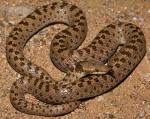
|
DESERT NIGHTSNAKE Hypsiglena chlorophaea
|
DESCRIPTION:
A small (up to 598 mm or 23" in total length) gray, or tan snake with small, dark, gray-brown blotches on the back (dorsal blotches). The dorsal blotches are usually in a single row but are sometimes offset at the midline of the back creating two rows of small, alternating blotches. |
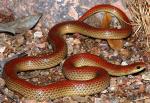
|
GROUNDSNAKE Sonora semiannulata
|
DESCRIPTION:
A small (up to 483 mm or 19" in total length) snake with extremely variable coloration and markings. Several different color/pattern morphs can be found at the same locality. |
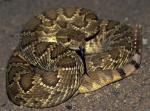
|
MOHAVE RATTLESNAKE
Crotalus scutulatus
|
DESCRIPTION:
A large (up to 1,270 mm or 50" in total length excluding rattle), tan, olive, or gray-brown rattlesnake with a series of dark blotches running down the back. The blotches have dark edges and uniform brown, dark gray, or olive-brown centers. |

|
ROSY BOA Lichanura trivirgata
|
DESCRIPTION:
A medium-sized (up to 950 mm or 37" in total length), heavy bodied snake with three wide, dark brown, black, orange, or reddish-brown stripes on a light cream, tan, or gray background. The head is only slightly larger than the neck and the tail is relatively blunt. The eyes are small and the pupils are vertically elliptical. The scales are smooth. The scales on the top of the head are small and rounded, unlike the large, flat head plates of most non-venomous snakes in Arizona. On males vestigial hind limbs are present in the form of two small spurs, one protruding from each side of the vent. |

|
SIDEWINDER Crotalus cerastes
|
DESCRIPTION:
A small (up to 628 mm or 25" in total length excluding rattle), tan, pinkish-tan, cream, or light gray colored rattlesnake with brown or gray-brown dorsal blotches. |

|
SPOTTED LEAF-NOSED SNAKE
Phyllorhynchus decurtatus
|
DESCRIPTION:
A small (up to 510 mm or 20"in total length) light tan, cream or pinkish tan snake with more than 17 brown or gray-brown blotches on the body. Smaller brown or gray-brown blotches mark the sides. |

|
TWIN-SPOTTED RATTLESNAKE
Crotalus pricei
|
DESCRIPTION:
A small (up to 660 mm or 26" in total length excluding rattle), blue-gray, pale gray, or gray-brown rattlesnake with two rows of small, dark blotches running down the back. |
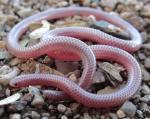
|
WESTERN THREADSNAKE
Leptotyphlops humilis
|
DESCRIPTION:
A small (up to 389 mm or 15" in total length), relatively thin, pink, gray, or mauve snake that resembles a shiny earthworm. Both the head and tail are rounded and blunt. The head is not distinct from the neck. |
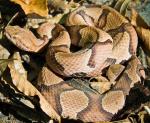
|
Agkistrodon contortrix contortrix - Southern Copperhead
|
Description
Southern copperheads reach an adult length of 24 to 26 inches (60 to 66 cm). They have a pale brown to light tan body, often with a pinkish tint. Their yellow eyes have elliptical or cat-like pupils. Its body, covered with rough scales, is patterned with dark, hour glass-shaped cross bands, wider at their base and narrow across the back. Copperheads have heat-sensing "pits" located between the eyes and nostrils, hence the name "pit viper". |

|
Agkistrodon contortrix laticinctus - Broad-banded Copperhead
|
Description
The Broad-banded Copperhead is light tan with broad reddish-brown or copper bands with a very thin white border. The number of bands varies from 10 to 17. It has a large head and hinged fangs that spring out when striking at prey or in defence. Young are usually much lighter in color with greenish yellow tips to their tails. |
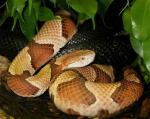
|
Agkistrodon contortrix phaeogaster - Osage Copperhead
|
Description
The Osage Copperhead has dark chestnut cross bands that are narrower in the center and wider on the sides, giving the bands an hourglass shape. There are also dark rounded spots at the sides of the belly. The head is a copper-red color. |

|
Agkistrodon piscivorus conanti - Florida Cottonmouth
|
Description
The Florida Cottonmouth is similar in pattern to A. p. piscivorus but has dark brown cheek stripe bordered above and below by narrow light lines. It has two dark stripes at the front of the lower jaw, and two dark vertical stripes at the tip of the snout. Mature specimens often lack any pattern on the back. |
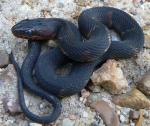
|
Agkistrodon piscivorus leucostoma - Western Cottonmouth
|
Description
The cottonmouth is a dark, stout, thick-bodied venomous snake. When frightened, the cottonmouth will pop its mouth open. The skin inside its mouth is bright white-and the reason it is called "cottonmouth." Most adults average 30-42 inches (76-106.7 cm) long. They are dark, grayish-brown with little or no markings. Very old cottonmouths may be entirely black. Its broad, flat head distinctly wider than its neck, and it has an elliptical (cat-like) pupil. By day the pupil appears as a narrow slit; at night the pupil is wide and may even look round. |
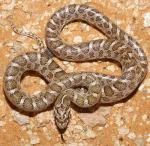
|
Arizona elegans elegans - Kansas Glossy Snake
|
Description
The glossy snake and its many subspecies are all similar in appearance to gopher snakes. However, they are smaller than gopher snakes, with narrow, pointed heads, and a variety of skin patterns and colors. |
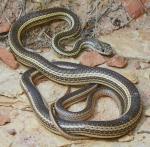
|
Arizona elegans philipi - Painted Desert Glossy Snake
|
Description
The Painted Desert glossy snake is typically a light tan brown in color, with darker brown blotches down the length of the back. This subspecies usually has around 60 blotches, more than other subspecies. Each blotch is usually edged with black. Their underside is usually solid cream or white in color. Their coloration can vary, lighter or darker, depending on the soil and elevation of their localized habitat, with specimens from higher elevations often being darker in color. They can grow from 20 to 35 inches in length (50 to 90 cm). They have a thin body, smooth scales, and eyes with round pupils. |
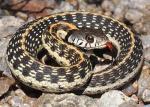
|
BLACK-NECKED GARTERSNAKE
Thamnophis cyrtopsis
|
DESCRIPTION:
A medium (up to 1,070 mm or 42" in total length) dark olive-gray snake with a single orange-yellow stripe down the middle of the back (mid-dorsal stripe) and an additional cream or white stripe along each lower side on the 2nd and 3rd scale rows (counting up from the belly). |

|
BLACK-TAILED RATTLESNAKE
Crotalus molossus
|
DESCRIPTION:
A large (up to 1,219 mm or 48" in total length excluding rattle), brown, gray, yellow-brown, or golden yellow rattlesnake with a series of large, black or brown, blotches on the back (dorsal blotches). |
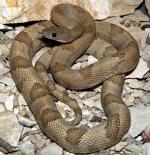
|
Bogertophis subocularis subocularis - Trans-Pecos Ratsnake
|
Description
It has a row of small scales (suboculars) between the lower border of the eye and the upper labials. This is a beautiful snake, yellow to tan dorsally with a series of black or dark brown H-shaped markings. The eyes are large and prominent, light-colored with contrasting round black pupils. The tongue is pink. Dorsal scales in 31-35 rows. Ventrals 260-277; subcaudals 69-79. |
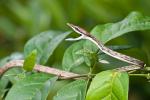
|
BROWN VINESNAKE Oxybelis aeneus
|
DESCRIPTION:
A long (up to 1,620 mm or 60" in total length) and exceptionally thin snake that closely resembles a vine. Coloration ranges from gray to silver-gray or copper with short, dark, dash-like lines at mid-body. The head is very narrow, pointed, and elongated. |
|
|